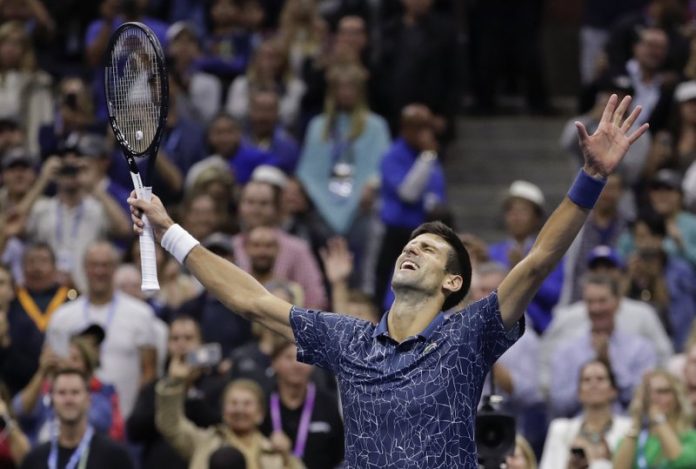
NEW YORK – Now that Novak Djokovic has the same number of Grand Slam titles as his childhood idol, Pete Sampras, it’s realistic for him to start thinking about chasing the only two men ahead of him, Roger Federer and Rafael Nadal.
If Djokovic is reluctant to speak publicly about the idea of going from his current total of 14 to Nadal’s 17 or Federer’s 20, the Serb’s coach isn’t.
“The 14 is a number. I mean, it’s amazing: 14!” Marian Vajda said Sunday night with a giddy chuckle, his eyes wide, after Djokovic got there with a 6-3, 7-6 (4), 6-3 victory over Juan Martin del Potro in the US Open final.
“Years ago, I would say that Rafa and Roger went too far from him, you know? Too (far) ahead of him with the Grand Slams. Now I have a feeling he’s (catching) up with them,” Vajda continued, slapping the back of his right hand on his left palm for emphasis. “He’s so close now, three from Rafa and six – OK, six is still unbelievable – away (from) Roger.”
“Amazing” is a perfect word for this trio, which is rightfully back atop the rankings for the first time in 3½ years, with Nadal at No. 1, Federer at No. 2 and, as of Monday, Djokovic at No. 3.
They have combined to win 47 of the past 55 major championships, dating to the 2005 French Open.
That’s 85 percent. Quite a contrast to the current state of the women’s game, where eight players won the past eight majors.
Here’s another way to think about it all: When Sampras beat Andre Agassi in the 2002 US Open final, in what would turn out to be Pistol Pete’s last professional match, it not only established a new record for men’s Slam trophies at 14, it also was two more than anyone else in history had managed to collect.
And now? Sampras has been equaled or surpassed by three players – and it’s only 16 years later.
Matching him was meaningful to Djokovic, whose earliest memories of tennis involve watching Sampras on TV at Wimbledon.
“There is a lot of significance of me being, now, shoulder-to-shoulder in terms of Grand Slam wins with him. It’s truly incredible when you think about it. I watched him win one of his first Wimbledon championships, and I grew up playing and thinking that one day I’ll be able to do what he does,” Djokovic said. “To actually be here, it’s a dream come true.”
Agassi, who finished with eight majors, and Sampras used to credit each with making the other better.
Same goes for the Big 3 of today (with all due respect to Andy Murray, he of the three majors plus two Olympic singles gold medals, it really isn’t a Big 4).
“Maybe 10 years ago, I would say I’m not so happy to be part of this era with Nadal and Federer. Actually, today I am. I really am. I feel like these guys, rivalries with these guys, matches with Federer and Nadal, have made me the player I am, have shaped me into the player I am today,” Djokovic said, his shiny silver U.S. Open trophy resting a few feet away.
“I have utmost respect for what they have achieved on the court, but also the champions, role models, they are off the court. I think we have pushed each other to the limit every time we get to play each other. For me, that was always an ultimate challenge: to play Nadal or Federer anywhere,” Djokovic continued.
“I had to figure out early in my career, when I was losing most of the big matches @ the Grand Slams against them, what it takes for me to actually kind of improve and develop my game to be able to challenge them, to be able to start winning against them when it matters the most. I think that was one of the most important, so to say, moments and periods of my life, my tennis career, my development. I owe it to them.”
The other beneficiaries: tennis fans.
And now the world gets to watch the next phase of this and wonder: How many more majors can Federer, 37 and coming off a fourth-round exit at the US Open, add to his total? What about Nadal, 32, who retired from his semifinal at Flushing Meadows because of pain in his right knee, a problem off-and-on for years?
After Djokovic, 31, watched them increase their advantages over him while he went more than two years without a major, hampered by an injured right elbow that required surgery in February, he is now got his game in order. He showed off all of his court-covering, foe-frustrating, defense-to-offense skills down the stretch on the way to his third US Open title, claiming the last 16 sets he played.
As Vajda put it: “Back at his best.”
Let the chase begin. (AP)







